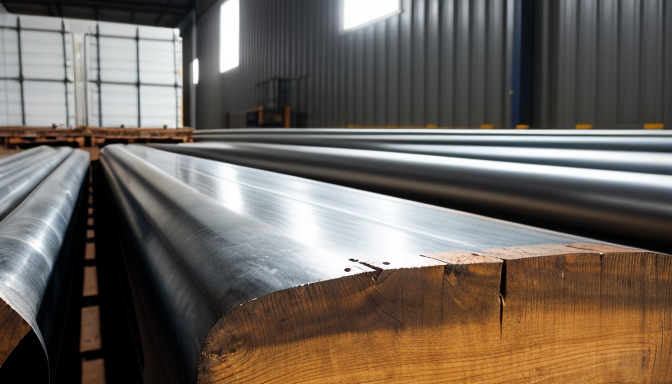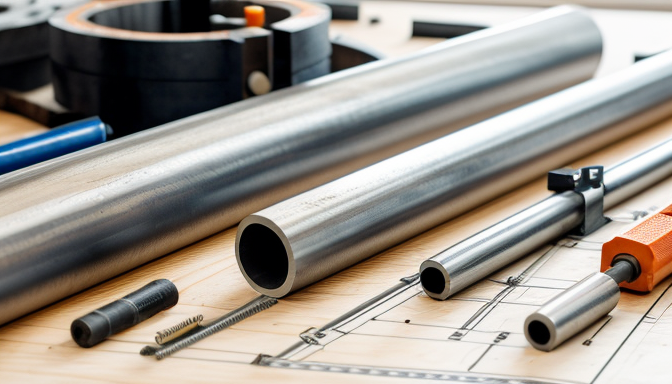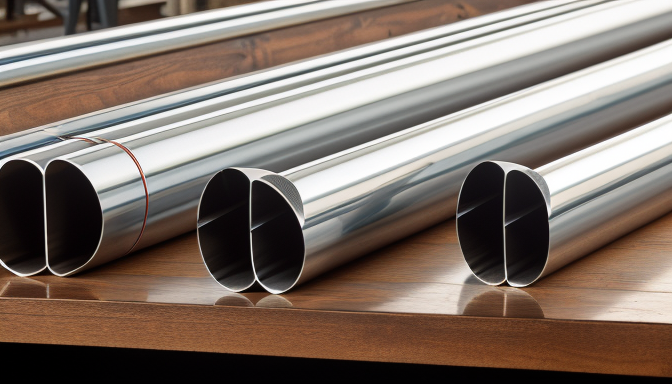Seamless steel pipes are essential components in many industries. They are known for their strength and durability. But what exactly makes them so special? Imagine a pipe that can handle high pressure without any weak points. That’s the beauty of seamless steel pipes. They are manufactured without any joints or welds, which makes them less likely to fail under stress. This is crucial for industries like oil and gas, where safety is paramount.
When it comes to applications, seamless steel pipes are everywhere. From construction sites to manufacturing plants, these pipes are used to transport fluids and gases. They are favored for their ability to withstand extreme conditions. Think of them as the backbone of infrastructure. Without them, many systems would falter. But how do you choose the right seamless steel pipe for your project? Let’s dive into some key aspects.
Understanding the pricing of seamless steel pipes can save you money. Prices vary based on several factors:
- Material Quality: Higher quality materials often cost more but offer better performance.
- Market Trends: Prices fluctuate with demand. Keeping an eye on market trends can help you buy at the right time.
- Regional Variations: Prices can differ by location due to shipping costs and local market conditions.
By considering these factors, you can make a more informed decision when purchasing seamless steel pipes.
The weight of seamless steel pipes is another important consideration. Why does it matter? Well, weight affects transportation costs and installation ease. Generally, the weight of a pipe depends on:
- Diameter: Larger pipes weigh more.
- Wall Thickness: Thicker walls add weight.
- Material Grade: Different grades of steel have varying densities.
Understanding these aspects can help you choose the right pipe for your needs.
Seamless steel pipes possess unique properties that make them ideal for various applications. Here are some key properties:
- Strength: They can withstand high levels of pressure.
- Corrosion Resistance: Many seamless pipes are treated to resist rust and corrosion.
- Thermal Conductivity: They can handle temperature changes effectively.
These properties make seamless steel pipes reliable in demanding environments.
Seamless steel pipes come in various sizes. This variety is crucial for meeting industry demands. But how do you choose the right size? It’s important to consider the application. For example, a large diameter pipe might be necessary for transporting oil, while smaller pipes may be used for plumbing. Knowing the standard dimensions can guide your selection.
In conclusion, seamless steel pipes are more than just tubes. They are vital for many industries, providing strength, reliability, and versatility. Whether you’re in construction, manufacturing, or another field, understanding these pipes can greatly enhance your projects.
Seamless Steel Pipe Price
Understanding the pricing factors of seamless steel pipes can help buyers make informed decisions. The price of these pipes can vary widely based on several factors. For instance, the quality of the material plays a significant role. Higher quality steel usually comes with a higher price tag. But why does quality matter? Well, better materials lead to stronger, more durable pipes that can handle the pressures of various applications.
Another important factor is market trends. Prices fluctuate based on demand and supply. For example, if there is a surge in construction projects, the demand for seamless steel pipes may rise, leading to higher prices. On the flip side, during economic downturns, prices may drop due to lower demand. Keeping an eye on these trends can save you money.
Additionally, regional pricing variations can affect costs. In some areas, transportation costs can inflate prices. For instance, if a manufacturer is located far from the end user, the shipping fees can add up quickly. Thus, understanding your local market can help you gauge whether you’re getting a fair deal.
Here’s a quick summary of what influences seamless steel pipe prices:
- Material Quality: Higher quality often equals higher prices.
- Market Trends: Prices change with demand and supply.
- Regional Variations: Transportation costs can impact prices.
To give you a clearer picture, let’s take a look at a simple table that outlines the average prices based on different factors:
| Factor | Price Range (per ton) |
|---|---|
| Low-Quality Material | $500 – $700 |
| Medium-Quality Material | $700 – $900 |
| High-Quality Material | $900 – $1,200 |
In conclusion, being savvy about the price of seamless steel pipes is crucial. By understanding the factors that influence pricing, you can make better purchasing decisions. Whether you’re in construction, manufacturing, or any industry that relies on these pipes, knowing the ins and outs of pricing can save you time and money.

Seamless Steel Pipe Weight
The weight of seamless steel pipes is a critical factor that affects everything from transportation to installation. When you think about it, the weight can really change the game. Imagine trying to lift a heavy steel pipe without knowing its weight. It could lead to unexpected challenges, right? Understanding how weight varies with diameter, wall thickness, and material grade can save you a lot of headaches.
First off, let’s break down what influences the weight of these pipes. The diameter is a big player here. Larger diameters mean more material, which naturally increases the weight. For example, a pipe with a diameter of 10 inches will weigh significantly more than one that’s just 2 inches wide. But it’s not just about the diameter; the wall thickness also plays a crucial role. Thicker walls mean more steel, which adds to the overall weight.
Now, you might be wondering, how do we actually calculate the weight? It’s simpler than you think! The formula used is:
Weight (Outer Diameter - Wall Thickness) × Wall Thickness × Length × Density
This formula takes into account the dimensions of the pipe and the density of the steel, which is typically around 490 pounds per cubic foot. For instance, if you have a seamless steel pipe that is 6 inches in diameter, with a wall thickness of 0.5 inches and a length of 10 feet, you can plug those numbers into the formula to get the weight.
To give you a clearer picture, here’s a quick table that outlines the approximate weights of seamless steel pipes based on common sizes:
| Diameter (inches) | Wall Thickness (inches) | Weight (lbs per foot) |
|---|---|---|
| 2 | 0.154 | 2.27 |
| 4 | 0.237 | 5.79 |
| 6 | 0.280 | 8.16 |
| 8 | 0.322 | 11.55 |
| 10 | 0.365 | 15.10 |
As you can see, the weight can vary quite a bit. This is important when planning for transportation. Heavier pipes require more robust equipment to move them around. Also, consider the installation process. If the weight is too high, it might need special machinery or more workers to handle it safely.
In conclusion, understanding the weight of seamless steel pipes isn’t just a technical detail; it’s a vital part of the planning process. Whether you’re ordering for a construction project or a manufacturing line, knowing the weight helps you make better decisions. So next time you’re dealing with seamless steel pipes, remember to factor in the weight!
Seamless Steel Pipe Properties
When it comes to seamless steel pipes, understanding their properties is key. These pipes aren’t just hollow tubes; they’re engineered to perform under pressure and in various environments. What makes them stand out? Let’s dive into their unique characteristics.
First off, one of the most impressive properties of seamless steel pipes is their strength. Unlike welded pipes, seamless pipes are made from a single piece of metal. This means they are less likely to fail under stress. Imagine trying to bend a solid rod versus a rod that’s been glued together. The solid one holds up much better, right? That’s the essence of seamless steel pipes.
Another critical property is corrosion resistance. Seamless steel pipes can be treated with various coatings to enhance their durability. This makes them ideal for industries like oil and gas, where exposure to harsh chemicals is a daily reality. You wouldn’t want your pipes rusting away in the middle of a crucial operation, would you? The right treatments can extend the lifespan of these pipes significantly.
Let’s not forget about thermal conductivity. Seamless steel pipes can handle high temperatures, making them suitable for applications in power plants and manufacturing. If you’ve ever cooked with metal pots, you know they get hot quickly. Similarly, seamless pipes can transfer heat efficiently, which is vital in many industrial processes.
To give you a clearer picture, here’s a quick rundown of some of the key properties of seamless steel pipes:
| Property | Description |
|---|---|
| Strength | High tensile strength due to one-piece construction. |
| Corrosion Resistance | Can be treated to withstand harsh environments. |
| Thermal Conductivity | Efficient heat transfer capabilities. |
| Pressure Handling | Designed to withstand high-pressure applications. |
In summary, the properties of seamless steel pipes make them a go-to choice for various industries. Their strength, resistance to corrosion, and ability to handle high temperatures set them apart. Whether you’re in construction, oil and gas, or manufacturing, knowing these properties can help you choose the right materials for your projects. So, next time you think about pipes, remember the seamless steel pipes and their remarkable capabilities!

Seamless Steel Pipe Sizes
When it comes to seamless steel pipes, size truly matters. Imagine trying to fit a square peg in a round hole. Frustrating, right? That’s why understanding the different sizes of seamless steel pipes is essential for any project. These pipes are available in a variety of dimensions to cater to the diverse needs of various industries. Whether you’re in construction, oil and gas, or manufacturing, knowing the right size can save you time and money.
Seamless steel pipes are typically measured in terms of diameter and wall thickness. The diameter refers to how wide the pipe is, while wall thickness indicates how sturdy it is. These two factors play a crucial role in determining the pipe’s strength and suitability for specific applications. For instance, a thicker wall usually means a stronger pipe, which is vital for high-pressure systems.
To give you a clearer picture, here’s a simple breakdown of common sizes:
| Nominal Pipe Size (NPS) | Outer Diameter (inches) | Wall Thickness (inches) |
|---|---|---|
| 1/2 | 0.840 | 0.109 |
| 1 | 1.315 | 0.133 |
| 2 | 2.375 | 0.154 |
| 3 | 3.500 | 0.216 |
These sizes are just a starting point. Depending on your project, you might need something custom. But don’t worry! Many suppliers can accommodate special requests. Just keep in mind that the larger the pipe, the heavier it becomes. This can impact transportation and installation costs.
So, how do you choose the right size? Start by considering your project requirements. Ask yourself:
- What is the intended use of the pipe?
- What kind of pressure will it need to withstand?
- Are there specific industry standards I need to follow?
By answering these questions, you can narrow down your options and select the most appropriate size for your needs. Remember, the right size can make all the difference in performance and safety. Don’t rush the decision—take your time to assess your options. In the world of seamless steel pipes, a well-informed choice can lead to successful outcomes.
Frequently Asked Questions
- What is a seamless steel pipe?
A seamless steel pipe is a type of pipe that is made without any welds or joints, which gives it enhanced strength and durability. This design makes it ideal for high-pressure applications and ensures a consistent flow of materials.
- How is the price of seamless steel pipes determined?
The price of seamless steel pipes can vary based on several factors, including the quality of the material, market demand, and regional pricing trends. Buyers should consider these elements to make informed purchasing decisions.
- What factors influence the weight of seamless steel pipes?
The weight of seamless steel pipes is influenced by their diameter, wall thickness, and material grade. Generally, larger diameters and thicker walls result in heavier pipes, which is an important consideration for transportation and installation.
- What are the key properties of seamless steel pipes?
Seamless steel pipes are known for their high strength, excellent corrosion resistance, and good thermal conductivity. These properties make them suitable for various applications, including oil and gas, construction, and manufacturing.
- What sizes do seamless steel pipes come in?
Seamless steel pipes are available in a wide range of sizes to meet the diverse needs of different industries. It’s essential to choose the right size based on specific application requirements, such as flow rate and pressure conditions.
- Where are seamless steel pipes commonly used?
Seamless steel pipes are widely used in industries such as oil and gas, construction, automotive, and manufacturing. Their reliability and performance in high-pressure environments make them a preferred choice for many applications.
